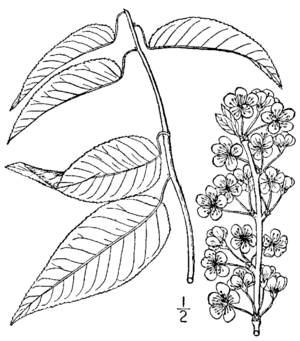Prunus hortulana facts for kids
Quick facts for kids Prunus hortulana |
|
|---|---|
 |
|
| 1913 illustration | |
| Conservation status | |
| Scientific classification | |
| Genus: |
Prunus
|
| Species: |
hortulana
|
The hortulan plum (scientific name: Prunus hortulana), also known as the wild goose plum, is a type of fruit shrub or small tree. It belongs to the rose family, which includes many well-known plants like apples and strawberries. This plant is native to the central parts of the United States.
Contents
Where Does the Hortulan Plum Grow?
You can find the hortulan plum growing naturally in many states across the central United States. These include Arkansas, Iowa, Illinois, Indiana, Kansas, Kentucky, Missouri, Nebraska, Ohio, Oklahoma, Tennessee, Texas, Virginia, and West Virginia. Sometimes, it's also found in states further east, like Massachusetts and Maryland. In these eastern areas, it likely spread there naturally over time.
This plum tree prefers to grow in forests on higher ground or near streams and rivers.
What Does the Hortulan Plum Look Like?
The hortulan plum is a deciduous tree, meaning it loses its leaves in the fall. It can grow quite tall, reaching about 6 metres (20 ft) (20 feet) or more. Its trunk can be up to 15 centimetres (5.9 in) (6 inches) wide.
Leaves, Flowers, and Fruits
The leaves of the hortulan plum are green. The top side of the leaves is smooth, but the underside feels a bit fuzzy because it has tiny hairs.
In the spring, beautiful white flowers appear on the tree. These flowers usually grow in small groups of two to four.
The fruits are drupes, which means they have a hard pit or stone inside, like a peach or cherry. They are edible and can be red or yellow, often with small white dots on their skin. People say these plums taste sweet and pleasant.
Growing Hortulan Plums
The hortulan plum is not just a wild plant; it has also been grown by people for its fruit. There are different types, called cultivars, that have been developed for farming. It can also create hybrids by mixing with other Prunus species.


